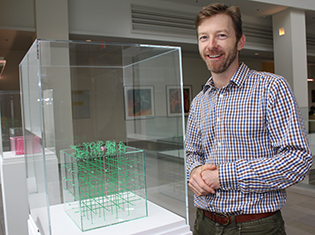Colleagues: Bevil Conway
Artist and Neuroscientist

PHOTO BY: KATHRYN DEMOTT, NEI
Bevil Conway’s glass and silk-thread sculptures are on semipermanent exhibit at NIH’s John Edward Porter Neuroscience Research Center (Building 35). He created the untitled green silk-thread sculpture in 2014.
The Artist:
When he is not in the lab, Bevil Conway (National Eye Institute) is a professional painter and sculptor who views his work as an artist as inextricably tied to his work as a neuroscientist. “The rules employed by artists have a strong basis in neural hardware,” he said. “I am fascinated by how we can use our understanding of the brain in order to understand the choices artists make.”
Our visual systems must constantly simplify the world around us because it is impossible for them to communicate everything about the visual world to the brain. As a result, “our visual systems extract what have turned out to be ecologically relevant cues—like edges and contrast—and don't bother with all the other stuff—like gradual changes in illumination or absolute levels of illumination,” he said. “Artists learn how to perform an analogous task: to extract and represent what they consider to be relevant pieces of their conceptual and visual worlds.”
Many of his works are displayed in private collections in Europe, Africa, and North America and are in the public collection of the Fogg Museum at Harvard University (Cambridge, Massachusetts) and the Boston Public Library, and some are on semipermanent exhibit at NIH’s John Edward Porter Neuroscience Research Center (Building 35).
The Scientist:
Current position: Investigator and chief of the Unit on Sensation, Cognition and Action Laboratory of Sensorimotor Research, National Eye Institute (jointly affiliated with National Institute of Neurological Disorders and Stroke, National Institute of Mental Health, and National Institute on Drug Abuse)
Education: McGill University, Montreal (B.S. in biology); Harvard Medical School, Boston (M.M.S.); Harvard University, Cambridge, Massachusetts (Ph.D. in neurobiology)
Training: Postdoctoral fellowships at Harvard Medical School and Bremen University (Bremen, Germany); elected a junior fellow in the Harvard Society of Fellows to pursue his combined interest in visual art and visual neuroscience
Before coming to NIH: Associate professor, Neuroscience, Wellesley College (Wellesley, Massachusetts); principal research scientist, Department of Brain and Cognitive Sciences, Massachusetts Institute of Technology (Cambridge, Massachusetts)
Came to NIH: In 2016
Interesting activities: After graduate school, he moved to Nepal to help develop the curriculum for a new medical school—the Kathmandu University Medical School
Research interests: Investigates the neural basis for visual perception; uses color perception as a model system for exploring how the brain processes physical stimuli from the retina. He uses functional magnetic-resonance imaging to study humans and macaques to better understand the architecture involved in how brains recognize faces, color, objects, and places.
This page was last updated on Tuesday, April 12, 2022
